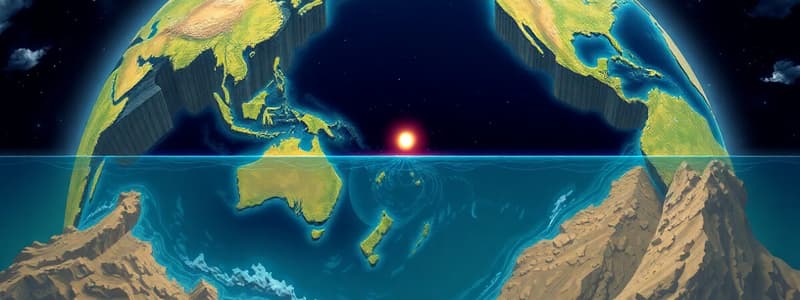Podcast
Questions and Answers
The Mediterranean Sea is considered to be in the final stages of its life cycle. What primary geological process is contributing to this?
The Mediterranean Sea is considered to be in the final stages of its life cycle. What primary geological process is contributing to this?
- Volcanic activity expanding the seafloor.
- Erosion from major river systems.
- The formation of new mid-ocean ridges.
- The African Plate subducting beneath the European Plate. (correct)
Which of the following mountain ranges was NOT a direct result of the Tethys Sea's closure and the collision of the Eurasian and African plates?
Which of the following mountain ranges was NOT a direct result of the Tethys Sea's closure and the collision of the Eurasian and African plates?
- The Ural Mountains. (correct)
- The Atlas Mountains.
- The Alps.
- The Himalayas.
What was the primary geographical role of the Tethys Sea during the Mesozoic Era?
What was the primary geographical role of the Tethys Sea during the Mesozoic Era?
- A deep ocean trench along the coast of South America.
- A small, isolated lake within the supercontinent Pangaea.
- A major seaway separating Gondwana and Laurasia. (correct)
- A shallow sea covering much of modern-day North America.
How did subduction zones contribute to the transformation of the Tethys Sea into the Mediterranean Sea?
How did subduction zones contribute to the transformation of the Tethys Sea into the Mediterranean Sea?
Which tectonic process directly led to the initial closure of the northern part of the Tethys Sea?
Which tectonic process directly led to the initial closure of the northern part of the Tethys Sea?
What geological feature is a direct result of the ongoing tectonic activity in the Mediterranean region?
What geological feature is a direct result of the ongoing tectonic activity in the Mediterranean region?
How did the closure of the Tethys Sea eventually lead to the formation of the present-day Mediterranean Sea?
How did the closure of the Tethys Sea eventually lead to the formation of the present-day Mediterranean Sea?
Which process explains the creation of smaller basins from the remaining oceanic crust as the Tethys Sea closed?
Which process explains the creation of smaller basins from the remaining oceanic crust as the Tethys Sea closed?
Flashcards
Mediterranean Sea
Mediterranean Sea
An ocean in the final stages of its life cycle, remnants of the Tethys Ocean.
Tethys Sea
Tethys Sea
A large oceanic basin that existed between Gondwana and Laurasia during the Mesozoic Era.
Plate Tectonics
Plate Tectonics
The theory explaining the movement of Earth's plates that shapes the planet's surface.
Subduction
Subduction
Signup and view all the flashcards
Mountain Building
Mountain Building
Signup and view all the flashcards
Alpine-Himalayan mountain belt
Alpine-Himalayan mountain belt
Signup and view all the flashcards
Basin Formation
Basin Formation
Signup and view all the flashcards
Ongoing Tectonic Activity
Ongoing Tectonic Activity
Signup and view all the flashcards
Study Notes
Mediterranean Sea: A Dying Ocean
- The Mediterranean is a remnant of the Tethys Ocean, in the final stages of its life cycle.
- Its size is shrinking due to the African Plate moving northwards, subducting beneath the European Plate.
- The Tethys Sea's transformation into the Mediterranean involved plate convergence, collision, subduction, mountain formation, and ocean basin closure.
Tethys Sea: A Prehistoric Ocean
- The Tethys Sea was a vast ocean separating Gondwana and Laurasia during the Mesozoic.
- It spanned across landmasses now including Europe, Africa, and Asia.
Continental Collisions: Shaping the Landscape
- Tectonic plate movement and continental drift led to significant collisions during the Mesozoic and Cenozoic Eras.
- A key collision was between the Eurasian and African plates, closing the Tethys Sea.
Subduction and Mountain Building: Building Up Continents
- Eurasian and African plate collision caused subduction, where one plate dives under the other.
- Subduction zones formed along the Tethys Sea's edges, squeezing the crust and creating mountain ranges like the Alps, Himalayas, and Atlas Mountains.
Closing the Tethys Sea: Isolation of the Mediterranean
- The Eurasian and African plate collision progressively closed the Tethys Sea, first in the north (Alpine-Himalayan belt), and later in the south (Atlas Mountains and Mediterranean isolation).
Basin Formation: Transformation of the Ocean Floor
- As the Tethys Sea shrank, its remaining oceanic crust transformed into smaller basins, including the modern Mediterranean.
- Back-arc spreading over continental margins created these basins.
Ongoing Tectonic Activity: A Dynamic Region
- The Mediterranean still experiences tectonic activity, with the African Plate's ongoing northward movement below the European Plate.
- This activity contributes to earthquakes, volcanic activity, and seafloor shifts in the region.
Studying That Suits You
Use AI to generate personalized quizzes and flashcards to suit your learning preferences.
Description
The Mediterranean Sea is shrinking due to the African Plate moving north. The Tethys Sea, a vast prehistoric ocean, transformed into the Mediterranean through plate convergence, collision, and subduction. Continental collisions between Eurasian and African plates shaped the landscape.
